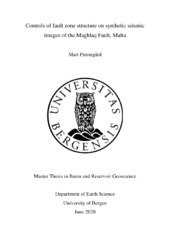Controls of fault zone structure on synthetic seismic images of the Maghlaq Fault, Malta
Master thesis
Permanent lenke
https://hdl.handle.net/1956/22976Utgivelsesdato
2020-06-25Metadata
Vis full innførselSamlinger
- Master theses [106]
Sammendrag
Application of seismic reflection data and 2D seismic modelling studies based on field analogues, contribute to closing the scale gap between field observations and interpretation of seismic data. This has improved the understanding of structurally complex reservoirs, with special focus on the impact faults and fractures have on e.g., hydrocarbons, water and CO2- storage in the subsurface. Seismic imaging of fault zones is inherently challenging because they are narrow zones of heterogeneously deformed rocks at the limit of seismic resolution. Modelling faults, which exert strong control on fluid flow, allow us to investigate their seismic signatures to further help seismic interpreters in the characterization of such structures in seismic data. In this thesis, realistic geological models were generated based on virtual outcrop models from exposed sections of the Maghlaq Fault situated in the Miocene-Oligocene carbonate succession in Malta. Through an efficient 2D seismic modelling approach, the fault zone architecture has been modelled with variation in fault elements, size, elastic properties, and fault geometry. In addition, modelling at different dominant frequencies show great variability in resolution and detail-level within the resulting synthetic seismic images. The Maghlaq Fault is characterized by the termination of footwall reflections and fault-related deformation. The obtained results of the imaged fault zone show a change in fault discontinuity associated with fault zone elements and geometries, as well as variation in amplitude and interference pattern owing to changes in elastic properties and the presence of sub seismic structures. Vertical and horizontal resolution in the seismic images is strongly controlled by the illumination and dominant frequency, and that the apparent dip of the fault is significantly lower in low-frequency (20 Hz) seismic images than the true dip. Furthermore, elastic properties impact the reflection characterization and delineation of structural geometries with intersecting acoustic impedance boundaries due to interference within the fault zone. Analysis of the synthetic seismic in this thesis may improve the understanding of the seismic signatures of fault zones.
